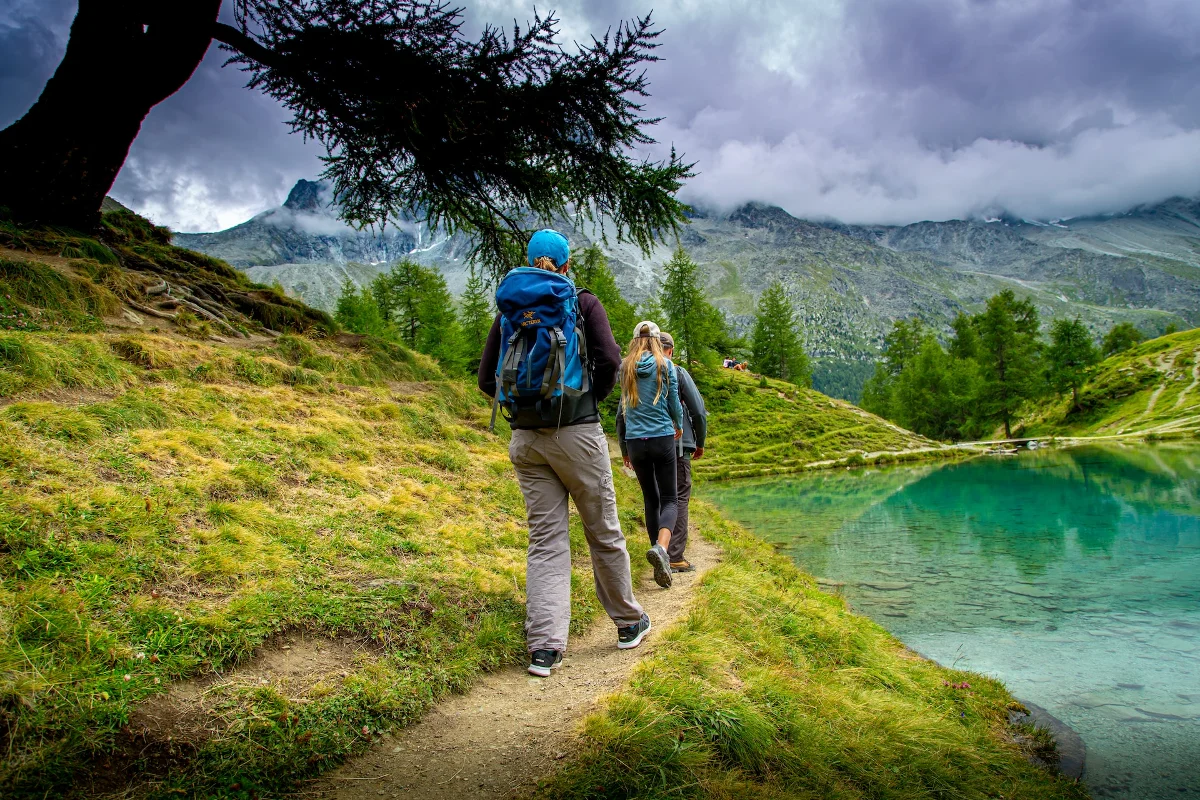Thinking about taking on a backpacking trip or even a full-on thru-hike? Maybe you’ve been on a few, and you’re just trying to refine your gear set up. You’ve probably heard the classic advice already. The answer is layers, always layers. The details can get a little fuzzy, though. What purpose do these different layers serve? What materials are best? Where should you invest the most money? I’ll give you an insider perspective on how to dial in your clothing for a thru-hike, to make sure you’re safe and warm without too heavy a pack.
Thru-Hiker Clothing: Base Layers
Everyone stresses the importance of a good base layer, and they’re right. It’s the layer closest to your skin, and it’s important from both a comfort and survival perspective. You’ll want merino wool. It’s just the standard. Merino wool wicks sweat better, doesn’t smell as bad as fast, and it’s comfortable. Brands like Icebreaker, Smartwool, or Minus33 are all good options.
When it comes to base layer use on a thru-hike, you might be surprised to learn that we thru-hikers don’t often hike in our base layer clothing. We’re more likely to treat them as pajamas, changing into them as a relatively clean set of clothes when we get to camp each night. In especially cold regions, you’re far more likely to want to hike in your base layers. In the heat, you’ll want to keep it from getting too sweaty and just walk in your thru-hiking clothes.
Thru-Hiker Clothing, Plain and Simple
What should you be hiking in? You may have heard the phrase, “cotton kills.” This is good advice. Stay away from cotton, it holds moisture, will make you cold, and is dangerous to rely on in the backcountry. When you’re thinking about materials, you’ll want merino wool again, nylon, or polyester blends. You’re looking for clothing that wicks sweat and dries quickly. When you get to camp each night, take off your hiking shirt, your shorts or pants, and hang them somewhere to dry. If you’re lucky, when you put them back on in the morning, they won’t be damp, cold, and disgusting. Maybe they’ll be dry, cold, and disgusting instead.
What about the fashion aspect, though? You’ll be wearing these clothes all day, every day. These are the ones that will stink the worst, take on the most sweat stains and salt residue, and just generally be filthy. So, they might as well look cool. Thru-hikers tend to like clothing with bright colors and cool patterns, statement pieces that let the rest of the community know who you are. They don’t need to be expensive, either. Thrift shop finds are totally an option for thru-hiking clothes, and a good one, (so long as they’re not cotton.) And a word of advice from personal experience? Don’t wear white on a thru-hike.

Photo by Alex Guillaume
All-Important: Socks and Shoes
Don’t compromise financially on anything between you and the ground. This goes for beds, car tires, and shoes, especially if you’ll be hiking 20 miles a day in those shoes. Spend time and money finding the right pair of shoes for you. Everyone’s feet are so different that it’s almost impossible to give blanket advice here, but I’ll tell you that most thru-hikers wear trail runners over hiking boots. Stop into a good outfitter, have them measure your feet, and have a conversation. Do you need a wide toe box? How much cushion do you want? Do you need zero drop shoes? Insoles that offer arch support? These are questions you can only answer by trying shoes on and seeing what feels good. As a rule, your hiking shoes should be at least half a size bigger than your everyday shoes, because your feet will swell. If you’re going on an especially long thru-hike, you may find your feet swell even a full size larger over the course of a couple months.
What about socks? Guess what? You’ll want merino wool again, for its sweat-wicking qualities. That’s even more important in socks. Darn Tough or Smartwool are the standard brands. Picking up double-layered socks or using sock liners can be a great way to cut down on friction and prevent blisters, too. Don’t be afraid to stop and tape your feet when you feel a “hot spot” while hiking. Or, my secret ingredient? Raw wool. It does an even better job than tape at preventing friction.
Thru-Hikers Love Their Mid Layers
The mid layer’s role is in its name. It’s a medium-warmth sweater or fleece of some sort. It’s what you’ll toss on when you take breaks to keep warm, and most likely what you’ll live in at camp in moderate temperatures. There’s some flexibility here, between lighter or heavier mid layers. Alpha fleece is a relatively new, recently popular choice. It’s light enough to not make you sweat hiking in it, but adds significant warmth when another layer is used on top. The standard for fleece, though, is Melanzana. Thru-hikers love their “Mellys.” If you can’t quite make the pilgrimage to Leadville, brands like Sambob or Tumble On Outfitters offer custom, high-quality fleece as well.

Photo by Rathish Gandhi
Iconic Thru-Hiking Clothing: The All-Important Puffy
When it’s really, really cold, what are you gonna put on? The puffy jacket. Generally, your biggest choice with this piece of gear will be the choice of fill. Natural goose down or synthetic? You should choose based on how much rain you’re expecting. This goes for sleeping bags and quilts, too. Synthetic down will repel moisture better and stay more effective when damp. Goose down may be a little warmer or pack down a little better, depending on the jacket.
I remember when I was working at an outdoor retailer, talking to a hiker who was planning to embark on the PCT. She was thinking about opting for a lighter puffy that she could hike in. I let her know that, over two thru-hikes, I had almost never hiked in my puffy. Generally, your hiking will keep you warm when you’re moving. You want your puffy to be as warm as possible, since it’s your last line of defense for warmth when you’re not moving.
What’s the Call on Rain Gear?
You’ll need some for a thru-hike, that’s for sure. If you’re on the Arizona Trail or the desert sections of the PCT or the CDT, you might be tempted not to bring a rain jacket at all. I would suggest at least bringing some Frogg Toggs, an ultralight, budget-friendly option that will surely disintegrate in the long term. Even then, you’ll want a real rain jacket waiting in the wings. You could have it sent to you when the weather starts to turn. It’s something you won’t always use, but absolutely need to have. The harder decision is whether or not to bring rain pants. If you’re on the AT, the Pacific Northwest Trail, or any trail in the wetter months, I would advise bringing some along.

Photo by Nick Scheerbart
Transitioning Into Winter Mode
If you’re embarking on a thru-hike of the AT, PCT, or CDT, the question of what clothing to bring is vital, and it’s important to know that your circumstances will change as you go. In the hotter sections or months, you’ll want to stay as light as possible. Leave some of your cold weather gear at home, and bring just enough to stay safe and warm at night. Hopefully your sleeping bag or quilt can do the bulk of the lifting there. What you’ll want, then, is a warm beanie, gloves, and thicker socks on deck at home. You might also have a warmer mid layer or a warmer base layer ready. Pre-package them for a family member or loved one before you leave. That way, when it starts getting chilly, you can just message them, ask for your winter gear, and all they’ll need to do is stick the box in the mail.
Trial and Error
You’re going to mess up on your thru-hiking clothing choices a few times. You’ll pick the wrong shoes or the wrong pants or some similar mistake along the way. Remember that that’s part of the process, and you can always revise and try again. Try to preserve your bank account along the whole way, of course. Used gear sales are a great resource if you can find them. While this guide should start you off on the right foot, there’s an infinite amount of research you can do into specific pieces of clothing. You’ll find what works for you in time.
The post A Thru-Hiker’s Guide to Clothing appeared first on Outdoors with Bear Grylls.
https://outdoors.com/thru-hiker-clothing/
 CampingSurvivalistHuntingFishingExploringHikingPrivacy PolicyTerms And Conditions
CampingSurvivalistHuntingFishingExploringHikingPrivacy PolicyTerms And Conditions
